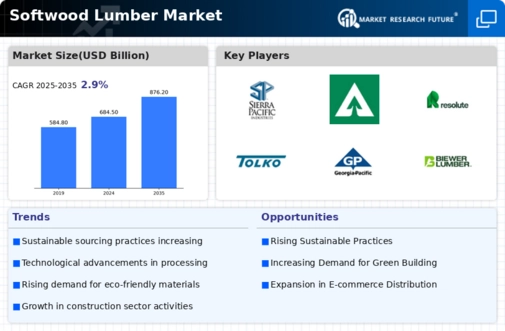Market Growth Projections
The Global Softwood Lumber Market Industry is projected to experience substantial growth, with estimates indicating a market value of 684.5 USD Billion in 2024 and an anticipated increase to 876.2 USD Billion by 2035. This growth trajectory suggests a compound annual growth rate (CAGR) of 2.27% from 2025 to 2035. Such projections highlight the increasing demand for softwood lumber driven by factors such as urbanization, sustainability trends, and technological advancements. The market's expansion is indicative of a broader shift towards renewable materials in construction and manufacturing, positioning softwood lumber as a critical component in future industry developments.
Sustainable Building Practices
The Global Softwood Lumber Market Industry is increasingly influenced by the rising demand for sustainable building materials. As environmental concerns gain prominence, architects and builders are opting for softwood lumber due to its renewable nature and lower carbon footprint compared to alternatives like steel and concrete. This shift is evident in various construction projects worldwide, where softwood is favored for its sustainability credentials. The industry's growth is projected to reach 684.5 USD Billion in 2024, reflecting a broader trend towards eco-friendly construction. This focus on sustainability not only enhances the appeal of softwood lumber but also aligns with global initiatives aimed at reducing greenhouse gas emissions.
Urbanization and Housing Demand
Rapid urbanization is a significant driver of the Global Softwood Lumber Market Industry. As populations in urban areas continue to swell, the demand for housing and infrastructure rises correspondingly. Softwood lumber is often the material of choice for residential construction due to its availability, cost-effectiveness, and ease of use. In many regions, particularly in developing countries, the construction of new homes and commercial buildings is accelerating, contributing to the industry's projected growth. By 2035, the market is expected to expand to 876.2 USD Billion, driven by this urbanization trend. The increasing need for affordable housing solutions further underscores the importance of softwood lumber in meeting these demands.
Diverse Applications Across Industries
The versatility of softwood lumber across various industries is a key driver of the Global Softwood Lumber Market Industry. Beyond traditional construction, softwood finds applications in furniture manufacturing, packaging, and even in the production of engineered wood products. This broad range of uses enhances its market appeal and ensures consistent demand. As industries continue to innovate and seek sustainable materials, the role of softwood lumber is likely to expand further. The market's growth trajectory, reaching an estimated 876.2 USD Billion by 2035, reflects this diverse applicability. The ongoing exploration of new uses for softwood products will likely contribute to sustained interest and investment in the sector.
Regulatory Support for Timber Products
Government policies and regulations promoting the use of timber products significantly impact the Global Softwood Lumber Market Industry. Many countries are implementing initiatives to encourage sustainable forestry practices and the use of renewable materials in construction. For example, regulations that favor timber over more carbon-intensive materials can enhance the competitive position of softwood lumber. This regulatory support not only fosters market growth but also aligns with global sustainability goals. As a result, the industry is poised for expansion, with projections indicating a market value of 684.5 USD Billion in 2024. Such policies are essential in driving the adoption of softwood lumber in various sectors.
Technological Advancements in Lumber Processing
Technological innovations in lumber processing are reshaping the Global Softwood Lumber Market Industry. Advances in milling, drying, and treatment processes enhance the quality and durability of softwood products, making them more appealing to builders and consumers alike. For instance, improved kiln drying techniques reduce moisture content more efficiently, leading to stronger and more stable lumber. These advancements not only increase production efficiency but also lower costs, thereby supporting market growth. As the industry adapts to these technologies, it is likely to see a steady CAGR of 2.27% from 2025 to 2035, indicating a robust future for softwood lumber in various applications.

















Leave a Comment